
 |
|
|||||||
| 1999 to 2003 7.3L Power Stroke Diesel 7.3L Power Stroke Diesel equipped Super Duty and Excursion |
|
|
Thread Tools | Display Modes |
|
#1
|
||||
|
||||
|
Because this ended up being longer than I expected, I'm writing this in two parts... Installation and Testing results. I am still compiling the the testing data so it is going to be another day or two before I get those results posted but wanted to get this started. So without further ado, here we go.
Part 1: Background and Installation Well, it had to happen sooner or later. Some wise-apple was going to not only throw an Adrenaline HPOP on a bone stock 7.3L, but also get froggy enough to slip an Overdrive in between the sheets (aluminum gasket sheets that is) just to see what's what. And not just any Overdrive, but the same nicely geared 1.667:1 setup that Matt is using on his truck. Actually, I would have posted in Matt's thread, but since the vehicle dynamics are a bit different (different HPOP and injectors) I thought it would be best to keep things separate. This is going to be a sizable post, so grab a drink, a slice of pizza, and get comfortable.  + + [/IMG] = [/IMG] =  Let's start with the basics. The truck is a bone stock, 2000 F250, 4WD, A/T, 3.73 Gears, 285/75-16 tires with 177,011 on the clock. The truck was originally an NVK4 but for testing purposes the PCM has been reflashed to a PMT1 calibration. For the sake of fairness, the test calibration levels were all based on the latest Evolution calibrations utilizing levels 1, 2 and 3 as well as a bone stock calibration for baseline. All datalogs are pulled with the engine running at normal operating temperature with a minimum of 30 minutes of driving to stabilize all fluid temperatures (coolant, engine oil, trans fluid, and fuel). Test runs were procured over the same stretch of road in order to help maintain test accuracy and eliminate any minor changes that may affect the results.  While this was definitely not the most technically challenging bolt-on I've ever done, you will need to be prepared to spend a couple hours on the installation. Because I have relatively small hands, I opted to leave the manifold Y-Pipe (spider) in place although those with larger hands may find it much easier to work with the spider removed. Just make absolutely sure you cover the intake openings with a rag so you don't drop any foreign objects down into the heads. I also must add that I was quite impressed that the whole installation works perfectly with the original fuel bowl. The only clearance issue I experienced was between the passenger side head fuel line and the relief nut on the HPOP. It only took a tiny bit of massaging to provide enough clearance to avoid fuel line failure down the road. Also, because we were running the stock fuel system and fuel bowl, those who have fuel bowl delete and regulated return systems may find this installation to be much simpler. One other thing for folks using the stock fuel bowl; Make sure you have a spare fuel filter and a set of fuel line seals (Ford Part # F81Z-9C387-BA). You may also want to consider replacing the water drain valve (Ford Part # F81Z-9A153-AA) at this time since it will be extremely easy to access the mounting screws. Ford has indicated that they've seen an increase in the number of leaky drains since the release of ULS diesel fuel. WARNING: Before going any further, make sure the battery cables are DISCONNECTED! You will be working in close proximity to the alternator and the glow plug relay and AIH relay (if so equipped), not to mention the fuel system. All you need is one spark and the best you could hope for is figuring out how to get all the fire extinguisher chemicals off your engine. I know this is a dumb thing to have to say, but it's amazing how often this simple thing is overlooked or ignored. I started by using a fluid transfer pump to empty the fuel bowl. I can't even begin to explain the crud that was located in the bottom of the bowl, but suffice to say that it wasn't pretty and was about ¼" deep.  After disposing of the fuel, I unbolted the 4 fuel lines (2 on the left and 2 on the right), removed the water drain tube, disconnected the heater/water sensor connector, removed the 2 fuel bowl bolts (located on the front of the reservoir) and the lifted the fuel bowl out of the way. This gave me a clear view of the stock pump. After disposing of the fuel, I unbolted the 4 fuel lines (2 on the left and 2 on the right), removed the water drain tube, disconnected the heater/water sensor connector, removed the 2 fuel bowl bolts (located on the front of the reservoir) and the lifted the fuel bowl out of the way. This gave me a clear view of the stock pump.Before going any further, I removed all remaining electrical connectors that would be in the way: IPR (back of HPOP), ICP (driver's head), EOT (back/right of reservoir), Oil Pressure (top of reservoir), EBP (front/left of timing cover), and ECT (front/right of timing cover). I also removed the fan belt just for a little extra room. Using the pump, I also transferred all the oil from the HPOP reservoir into a clean, plastic bottle. This makes it easy to refill the reservoir when the installation is complete. Removing the access cover for the HPOP gear is easy enough. The tricky part is removing the steel tube that runs to the EBP sensor assembly which is incorporated into the access cover. I would recommend spraying the nut with WD40 or PB Blaster to help things loosen up. Once the steel tube is out of the way, the cover is removed and you can easily access the HPOP gear bolt. A long breaker bar (24" or better), a 3" extension and an 18mm socket make quick work of removing the bolt. The bolt is a standard thread and unscrews counter-clockwise. Be careful to not drop the washer when removing the bolt, although if you should happen to, don't worry. The washer will not fall below the cam gear and can be easily fished out with a magnet. Moving on to the HPOP, I removed the two high pressure oil lines via the quick disconnect coupler and then removed the two HPOP mounting bolts. A light tap on the back of the HPOP and it slides right out. I took a little time at this point to clean out the engine valley, the fuel bowl (which was an absolute mess), and clean all mating surfaces for the pump and gear cover. Following the installation instructions, I prepped the Adrenaline and the Overdrive for installation, including installing the new IPR and replacing all o-rings on the fittings. Here's the shiny, happy fuel bowl... (click to enlarge...) 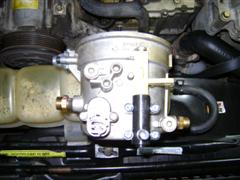 (click to enlarge...) 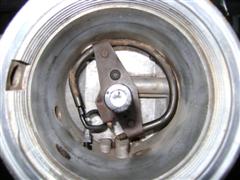 Installation was little more than the reverse of the removal process. I began by placing the Adrenaline HPOP into the engine valley and sliding it back so it was positioned under the spider. Make sure that the mounting bolts are already in place as you will not have room to install them later. With the HPOP pushed back, this gave me enough room to slip the Overdrive into place (making sure the gasket was properly in place) and reattach the drive gear (this actually helps hold the pump in place). I slid the HPOP forward (again, making sure the gasket was properly in place), inserted the nose into the rear of the Overdrive, and then slid the bolts all the way in. At this point, the only catch I had was the fuel line to the passenger's side head (the left/rear line). It was hitting the HPOP relief valve nut. What I ended up doing was placing a flathead screwdriver in between the nut and the fuel line to act as a wedge and then pulled the front of the line (where it attaches to the fuel bowl) slightly forward about 3/8". The line actually bends fairly easily so this wasn't too difficult. The HPOP bolts were then tightened to 15 Ft./Lbs. (click to enlarge...) 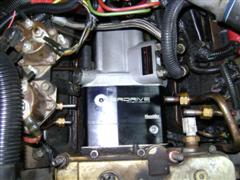 (click to enlarge...) 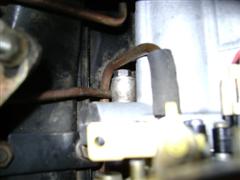 (click to enlarge...) 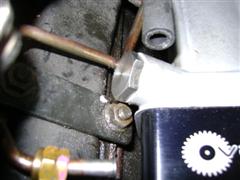 The rest of the installation was a snap. With the Adrenaline and Overdrive tight, I torqued down the drive gear bolt to 95 Ft./Lbs. (You may need someone to hold the crankshaft balancer bolt so the engine doesn't turn) I then reinstalled the HPOP gear access cover, the EBP tube, and all electrical connectors except the one to the fuel bowl. The high pressure oil lines snap right into the pump fittings and can be adjusted to make sure they're not rubbing anywhere. You will want to check the passenger side line as it tends to want to lie against the Wastegate Solenoid and Air Charge Sensor harness. The driver's side line had no clearance problems. At this time, I highly recommend changing the fuel line seals. The old ones are a bit tricky to remove as they conform to the fuel line nuts, but with a small screwdriver or a pick they can be removed quite easily. Just insert the screwdriver in between the seal and the nut and, holding the seal in place against the fuel line, unscrew the nut off the seal. Make sure to lightly oil the new seals when reinstalling. With the new seals in place, I reinstalled the (now spotless) fuel bowl along with a new fuel filter. I reattached the fuel bowl heater connector, the water drain tube, and the fan belt, and then gave everything a good once-over to make sure all connections were tight. This is a good time to double check that the left/rear fuel line is not making any contact with the HPOP. If necessary, use a flathead screwdriver to slightly bend the line a bit to make sure that there is at least 5/16" to 3/8" clearance. Otherwise, the line will chafe and a fuel leak could develop. I was good at this point with more than enough clearance. I refilled the reservoir with oil and snugged up the bolt. Another quick double-check and we're ready to go. You will want to hit the key a few times to make sure that the fuel bowl is purged of all air. This may take 3 or 4 key cycles. I generally just turn the key on until the Wait to Start light goes off and then cycle the key again. Feeling satisfied that the fuel bowl was full and that there weren't any leaks coming from the fuel lines, I cranked the engine over. The engine spun for about 6 to 8 seconds and then cracked off without a problem. After about 15 seconds of mild rough idle, the engine smoothed right out. So far, so good. I went back and started checking for any fuel or oil leaks. Everything looked good so I let the engine sit and warm up while I cleaned up and put my tools away. This pretty much covers the installation. This isn't what I'd consider to be an exhaustive set of installation instructions, but more just my recollection of the install and what advice I have to offer to those who are considering installing the Overdrive and/or Adrenaline on their truck. Obviously, installing just an Adrenaline is going to be considerably easier since it bolts directly in place of the original HPOP and doesn't have any of the minor clearance concerns that you might experience when installing the Overdrive. Overall, I'd say that the installation was relatively low difficulty and the instructions were very detailed which made everything easy to follow. In fact, my only deviation from the instructions was to remove the fuel bowl from the reservoir instead of removing the reservoir itself. Removing the reservoir might actually make more sense for less experienced folks because it provides clear access to the HPOP drive gear as well as a bit more working room when maneuvering with the HPOP or Overdrive. Stay tuned for Part 2: Initial Impressions and Test Results 
__________________
Bill Cohron - The Mad Doctor    Power Hungry Performance - The ORIGINAL in Ford performance tuning... Since 1996! (678) 890-1110 www.gopowerhungry.com - Home of the Hydra Chip, Minotaur Tuning Software, and the new Orion Reflash System for Navistar! Bring back  Windows™ XP and 7. Windows™ XP and 7.   Windows™ Vista and Windows™ Vista and  Windows™ 8 is a pain in my a$$! Windows™ 8 is a pain in my a$$!   Windows™ 10 is only slightly less annoying! Windows™ 10 is only slightly less annoying! 
Last edited by Power Hungry; Sat, December 26th, 2009 at 06:59 AM. |
|
|